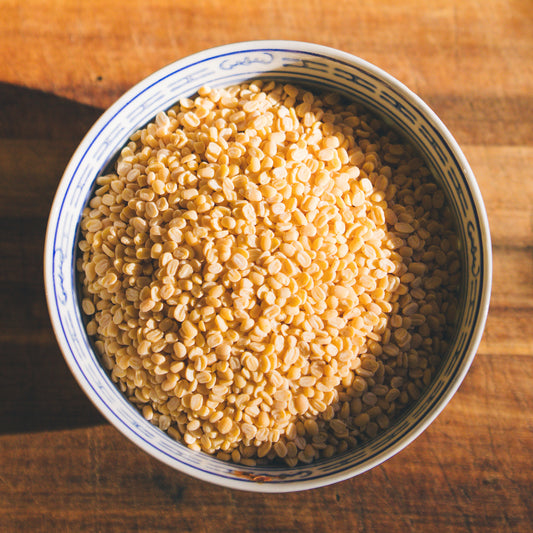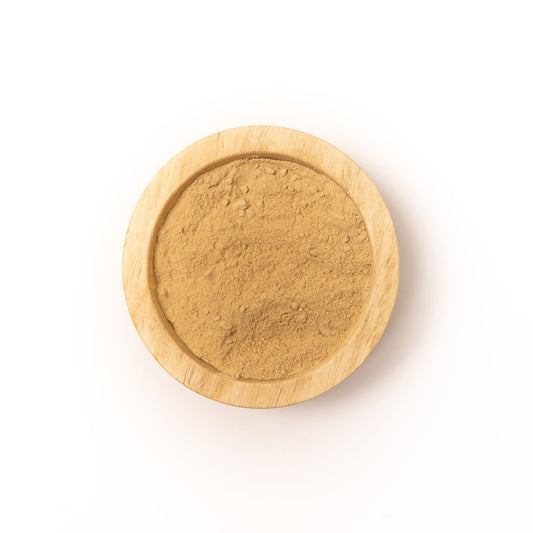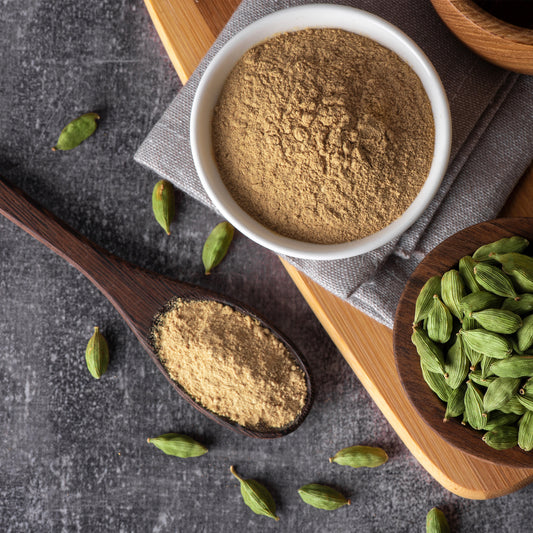This new year, many of us will resolve to make changes within our diet and lifestyles that will enable us to live happier and healthier lives. Resolutions are helpful because they motivate us to develop discipline and organize our lives for the year ahead. If your New Year's resolutions include losing a few pounds, Ayurveda offers some helpful recommendations to support your efforts.
Being overweight is generally a kapha or water-type disturbance. When there is excessive kapha dosha in the body there can be an accumulation of toxins, known as ama, causing the body to become lethargic, heavy, and dull. This can manifest as excess adipose tissue in the body, particularly at the chin, chest, belly, and thighs. A person with this condition can seem averse to change and may need motivation to get moving and lose the extra weight.
The main causes of being overweight are:
- Overeating (particularly foods that are heavy and sweet)
- Oversleeping (particularly sleeping during the day)
- Living a sedentary lifestyle
- Poor posture
- Insufficient exercise
An individual can keep kapha dosha in balance by getting enough exercise and not overeating. Although the solution to weight loss is clearly to burn more calories than you consume, Ayurveda offers a holistic way to manage your weight with diet, lifestyle, and herbal recommendations to make this formula a success.
Diet
Follow a kapha-reducing diet including foods that have light, drying, and reducing qualities. Grains such as barley, millet, quinoa, or legumes like split mung, red lentils, and aduki beans are excellent choices. Vegetables should be steamed, roasted, or stir-fried using a minimal amount of high quality vegetable oil or ghee. Avoid heavy, dense, and cold foods such as meat, cheese, ice cream, and sugary desserts. These will increase kapha dosha in the body.
Many times individuals with a kapha imbalance will tend to have low agni, the digestive fire. Even if a person's appetite is strong, the digestive action of the tissues may be weak leading to the accumulation of toxins and fat in the body. This is why it is very important to eat only when you are hungry.
Eat heavier meals when your digestive power is the strongest, during mid-day. Always allow enough time for your body to digest a meal, typically four hours.
Overlapping of meals impairs digestion and promotes ama formation. Have a lighter breakfast and dinner. Be careful not to overeat.
Ayurveda suggests one anjali, which is the quantity your two hands cupped together can hold, as an ideal amount of food to consume for a meal.
- Avoid ice cold beverages.
- Sip hot water with lemon juice or ginger tea with meals and throughout the day.
- Include warm digestive spices in your diet such as ginger, cloves, cardamom, and black pepper.
- Have meals that are fresh, warm, and easy to digest.
- Choose healthful snacks such as raisins or carrot sticks.

Herbs
Herbal remedies are powerful medicine and an integral part of an Ayurvedic health regime. Trim Support combines traditional Ayurvedic herbs such as punarnava, chitrak, vidanga, guggulu, and other herbs to support proper metabolism, eliminate excess kapha, promote elimination of natural toxins and support healthy digestion. Another option is Trim Balm. Trim Balm combines these same powerful herbs with kapha-reducing oils in a form that can be applied topically to specific areas of the body where kapha accumulates.
An herbal remedy that specifically targets digestion is Trikatu. Trikatu combines three pungent herbs to kindle the digestive fire and stimulate the metabolism. When your body is able to digest efficiently, your body is better at breaking down food and getting proper nutrients. The better your digestion, the less food needed to feel satisfied.
Another important aspect of weight management is improving the efficiency of elimination. Daily bowel movements are important for removing waste from the body. Triphala gently facilitates the removal of excess waste from the body, but is non-habit forming and can be used daily or as needed. Another benefit of Triphala is that it acts to detoxify the body. Toxins in the form of undigested food can deplete energy and inhibit efficient digestion of food. Triphala is the optimal Ayurvedic formula for detoxification as it can promote healthy energy levels and allow maintenance of ideal weight.
Lifestyle
To reduce kapha in the body, get moving! Kapha's qualities are slow and dense. Exercise brings numerous benefits to the body. Aside from burning fat and managing weight in the body, exercise imparts the feeling of lightness and happiness. Find an activity you love, preferably something involving conscious movement such as swimming, walking, or yoga.
Whatever form of exercise you choose, it should be practiced consistently and at a vigorous pace. Weight lifting is also very effective in helping the body to burn calories at a rapid rate. If you do not enjoy simply lifting weights, try walking with weights in your hands.
Having a partner to exercise it with is both fun and rewarding. Committing to exercise with someone helps to keep you motivated and stimulated, enlivening your exercise routine so that it is something that you look forward to each day. Particularly during the winter season, when kapha dosha is most susceptible to accumulation, it is very important to stay balanced.
- Stay warm and dry.
- Try dry body brushing before bathing to stimulate the lymphatic system and increase circulation.
- Take regular steams to help liquefy and move kapha from the respiratory system.
- Aromatherapy oils of eucalyptus, sage, camphor, and allspice can all be stimulating and beneficial for kapha.
- Do not sleep during the day. This slows the metabolism.
Yoga
To reduce kapha, yoga asanas should be practiced more vigorously and aerobically. Sun Salutations, or any continuously linked yoga practice including many standing postures such as Palm pose and Triangle pose, can help to raise the heart rate and increase circulation while burning more calories. Also beneficial are asanas that target the sites of kapha dosha (lungs, stomach) such as Cow, Camel, and Boat pose.
For more information on kapha-reducing yoga, click here. You will find photos and descriptions of various poses along with tips on how to optimize your practice for your constitution.

Pranayama
You can use the breath to help the body increase the rate at which it burns fat. The Breath of Fire, or Bhastrika pranayama, is also known as the bellows breath. Air is drawn forcefully in and out of the lungs and just as a bellows adds more air to a fire to make it hotter, the rapid increase of air flow in the body produces inner heat, stoking the fire of the mind and body. This increase in the exchange of oxygen and carbon dioxide within the blood stream stimulates metabolism and helps to flush toxins from the system.
- Sit in a comfortable position with hands resting on the knees or interlaced at the navel center.
- Keep the head and spine straight and long.
- Close the eyes and relax the whole body.
- Breathe in a full inhalation into the belly.
- Exhale out forcefully through the nostrils, expelling all the air from the lungs.
- At the tail end of the exhalation, draw the navel towards the spine pressing the abdominal muscles.
- Allow the inhalation to follow naturally, becoming involuntary and easy.
- Repeat with a forceful exhalation and find a natural rhythm continuing for 1-2 minutes.
- Allow the breath to return to a normal rate. Keeping the eyes closed, notice the feeling inside.
Meditation
Meditate for stress relief and emotional balance. Stress can play a causative role in emotional eating. Some emotional factors include attachment, sentimentality, and greed. Low self esteem can also play a role in overeating. Some people carry extra weight as a form of security or protection.
By making a practice of clearing and calming your mind through meditation, you are able to better tune into your body's needs. Assessing your emotional state and identifying true hunger will allow you to make more mindful decisions about food, allowing any obsessive thoughts to fall away.
Lasting change requires patience, practice, and discipline. Draw on kapha's strength and stability in your commitment to yourself knowing that you are persevering towards a wholesome, healthy, more enjoyable life. These simple Ayurvedic weight loss tips can help you stay on course this year, feeling lighter and happier as you move toward your ultimate healthcare goal.
“If in our daily life we can smile, if we can be peaceful and happy, not only we, but everyone will profit from it. This is the most basic kind of peace work.”
The information provided in this article is not intended as a substitute for medical advice, but only to apprise the reader of basic Ayurvedic lifestyle information. The advice of a qualified health professional is recommended before making changes in diet or exercise routines.












